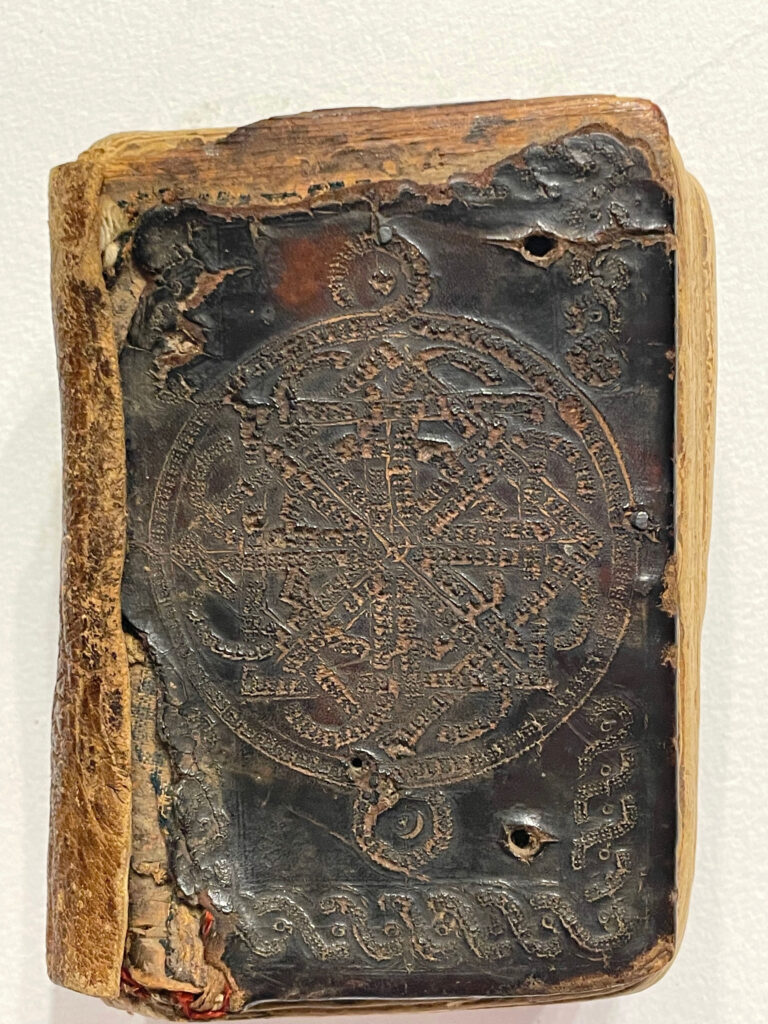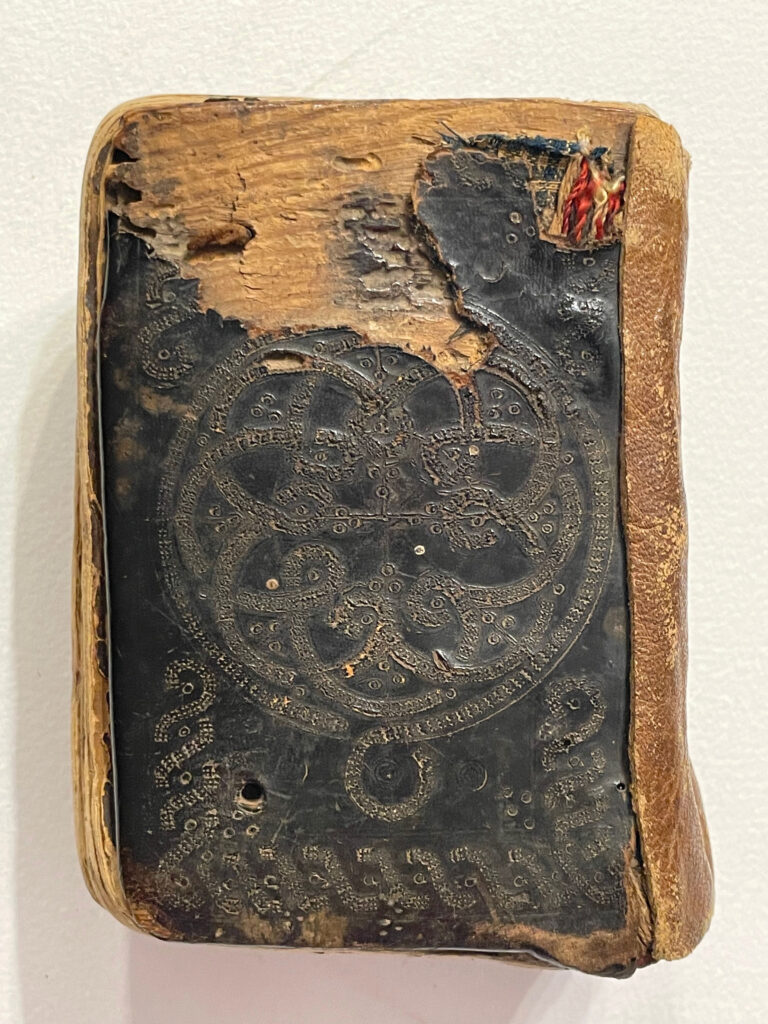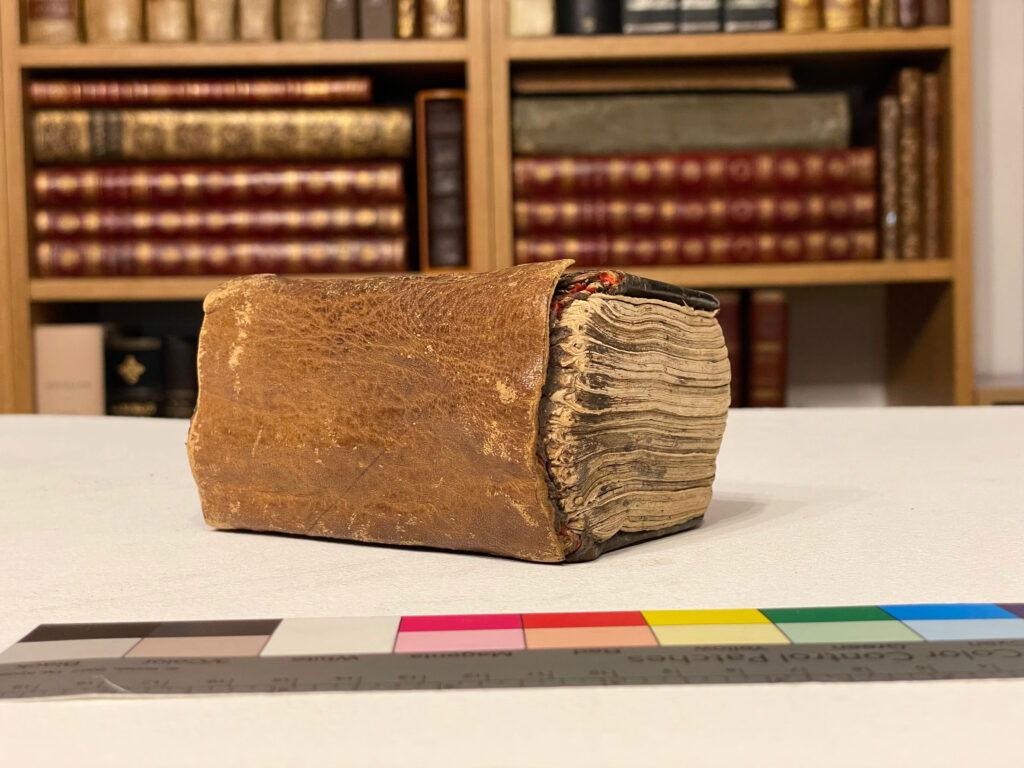An Unpublished Gospel Manuscript Colophon from a Private Collection in the United Kingdom
By Jesse Siragan Arlen
The historical value of the colophons of Armenian manuscripts has long been known to scholars of the premodern Near East, who have utilized them in various ways in a number of fascinating studies.[1] In addition to their inclusion in the manuscript catalogs of various repositories, separate publications exist that have grouped together colophons chronologically, making it possible to study colophons of a given period side-by-side.[2] Some 15,000 Armenian colophons have been published to date in such chronological series and many more await publication.[3] New avenues of inquiry that make use of the treasure trove of Armenian colophons point to the yet untapped potential provided by this rich repository of material.[4]
Like the manuscripts they conclude, each and every colophon is a uniquely precious remnant of the historical past meriting publication and study. This paper presents a transcription and translation of a colophon from an unpublished Gospel manuscript in a private collection in the United Kingdom. Shortly after the manuscript was acquired, photographs of certain pages were sent to me by the manuscript owner with the purpose of providing a brief description of the manuscript and a translation of the colophon. With the owner’s permission, images of the colophon and select pages of the manuscript are included here along with a transcription and translation of the colophon.
Colophons
A colophon (յիշատակարան, literally ‘place of remembrance’ or ‘memorial place’) is a note added by the copyist to the end of a manuscript. While no two colophons are exactly alike, most employ common formulae[5] and follow a somewhat standard structure, by which they may be considered a unique literary genre in their own right.[6] The typical Armenian colophon contains details about the following items, often in the following order: a doxological statement of praise to the Holy Trinity;[7] the contents of the manuscript copied; the date when and place(s) where it was copied; the contemporary religious and secular authorities, both local and international; the patron and sponsor of the manuscript, on whom praise is heaped and for whom—along with his or her named relatives—remembrance and prayer is requested; self-deprecating mention of the scribe himself and request for prayer for himself and his named relatives; the illuminator (if any) and binder; a historical account of contemporary political and religious developments. It is this final category, which can sometimes span several pages in length, that has made them such a coveted source for scholars of medieval history. Many other details may also be present, such as comments on the difficulties faced by the scribe while copying the manuscript, curses directed at potential thieves, poetic compositions,[8] and much else.[9]
Description of the Manuscript
The manuscript is bound in leather with an elaborate embossed cross and decorative border, and shows some signs of wear. See Images 1–3. The manuscript contains the Four Gospels and can be precisely dated to 1224 ad. The scribe, Filip-Tʿoros (Phillip-Theodore), specifies this as the date he completed it (673 ae) and also mentions two figures, whose reign, or term of office, coincide with this date: the Armenian Patriarch (Catholicos) Kostandin I of Cilicia (sed. 1221–1267); Philip of Antioch (king of Cilician Armenia, r. 1222–1225).[10] The scribe does not mention a patron and seems to have copied the manuscript on his own initiative and perhaps at his own expense. As he indicates, he was inspired to copy the Gospel manuscript after hearing the life of St. Alekʿsianos,[11] which was likely read aloud in his monastery. He does not mention where he copied the manuscript, but he was evidently in a monastery in Cilicia, judging by: (a) the political/religious figures he mentions; (b) his own name (Filip-Tʿoros), since the name Filip (Philip), especially with the initial letter ‘F’ (ֆ) signals his being from Cilician Armenia; (c) his own indication that he was a monk.
The manuscript is written in single columns in an unrefined bolorgir script (Filip-Tʿoros tells us that he received no formal scribal training and merely copied the handwriting of his exemplars), with a variable number of lines per page (twenty-five to thirty).[12] The letters/numbers in the margins of the text refer to the Eusebian canon table numeration, which indicate parallel passages between the Four Gospels.[13] There are no verse divisions, as the Gospel predates the introduction of verse divisions into Armenian Bibles (the first known example being a Bible owned by King Hetum II [r. intermittently 1289–1303], Matenadaran ms. no. 180). There are chapter headings marked by erkatʿagir (uncial) letters in red, but these do not correspond with the standardized chapters as known from modern Bibles (which were accepted later in the Armenian biblical tradition). Rather, they correspond with the division of pericopes as found in the Awetaran ateni.[14] All of the above attest to the authenticity of the manuscript as issuing from 1224 ad, as does the scribe’s use of the diphthong aw (աւ), instead of ō (օ).
The initial pages of the manuscript are missing, including any Eusebian canon tables that may have been present as well as the beginning of the Gospel of Matthew. The manuscript begins with Matt. 1:17: Եւ ի գերութենէն բաբելաց[ւոց] մինչեւ ի Ք[րիստո]ս ազգք չորեքտ[ասանք]. See Image 4. The Gospels of Mark, Luke, and John each begin with simple decorative pages. See Images 5–7. The disputed final pericope of Mark’s Gospel (16:9–20) is omitted, the scribe indicating his knowledge of its absence by the way in which the end of the Gospel of Mark is arranged in a spiraling pattern to occupy the space that would have been taken by the final pericope.[15] See Image 8. In the margin of Luke 22 (Judas’ betrayal of Jesus), Judas is depicted hanging from a pole, in line with the description of his death in Matthew 27:5. The image is captioned: խեղդած ‘choked.’ See Image 9. Beneath the end of the Gospel of Luke, the scribe has written: “Զանպիտան գրիչս զՖիլիպթորոս, յիշեսջիք ի Ք[րիստո]ս. եւ դուք յիշեալ եղիջիք (Remember in Christ the worthless scribe Filip-Tʿoros, and you also will be remembered).” See Image 7. The colophon spans four pages (transcription and translation below). See Images 10–11. Following the colophon are various readings taken from the Lectionary.[16] These were probably added to fill out the extra pages at the end of the manuscript, and they seem to have been added by a later scribe, since they appear to be written by another hand. See Image 12. The readings are the following: Isaiah 1:2–7;[17] 1 Corinthians 1:18–24;[18] Isaiah 61:3–6;[19] Hebrews 13:7–9;[20] Isaiah 52:7–8;[21] 2 Corinthians 6:16–18;[22] Acts 13:26–30;[23] Acts 8:26–30.[24]
The colophon contains interesting information about the scribe and his family, including the occupations and vocations pursued by him and his brothers, who seem to have belonged to the middle class. His parents Aṛakʿeal and Chokh (the latter a very rare name)[25] were already deceased at the time he copied the manuscript. His older brother, Barsegh, was a priest (քահանայ). Filip-Tʿoros was probably next in order of birth (since he mentions only Barsegh as an older brother), and he pursued a monastic vocation (ի տղայութեան հասակի առեալ զլուծ կրաւնաւորութեան). His next brother Mikhayl was a ‘commander priest’ (զաւրվար քահանայ).[26] His next brother, Yohannēs was a notary (նաւտար). Finally, his youngest brother, Gēorg, was a shoemaker (կոշկակար). He also had sisters, though he mentions none of their names.
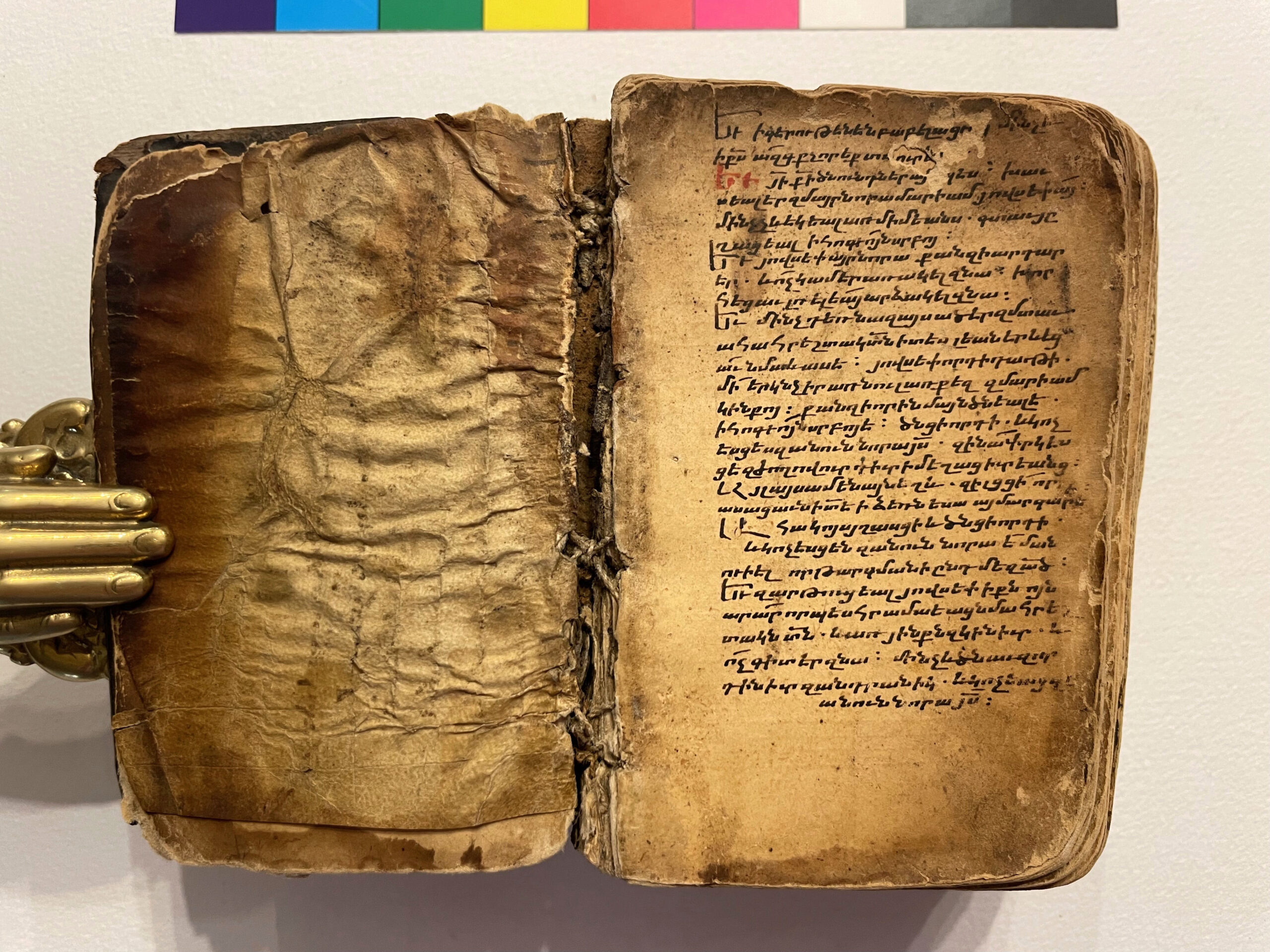
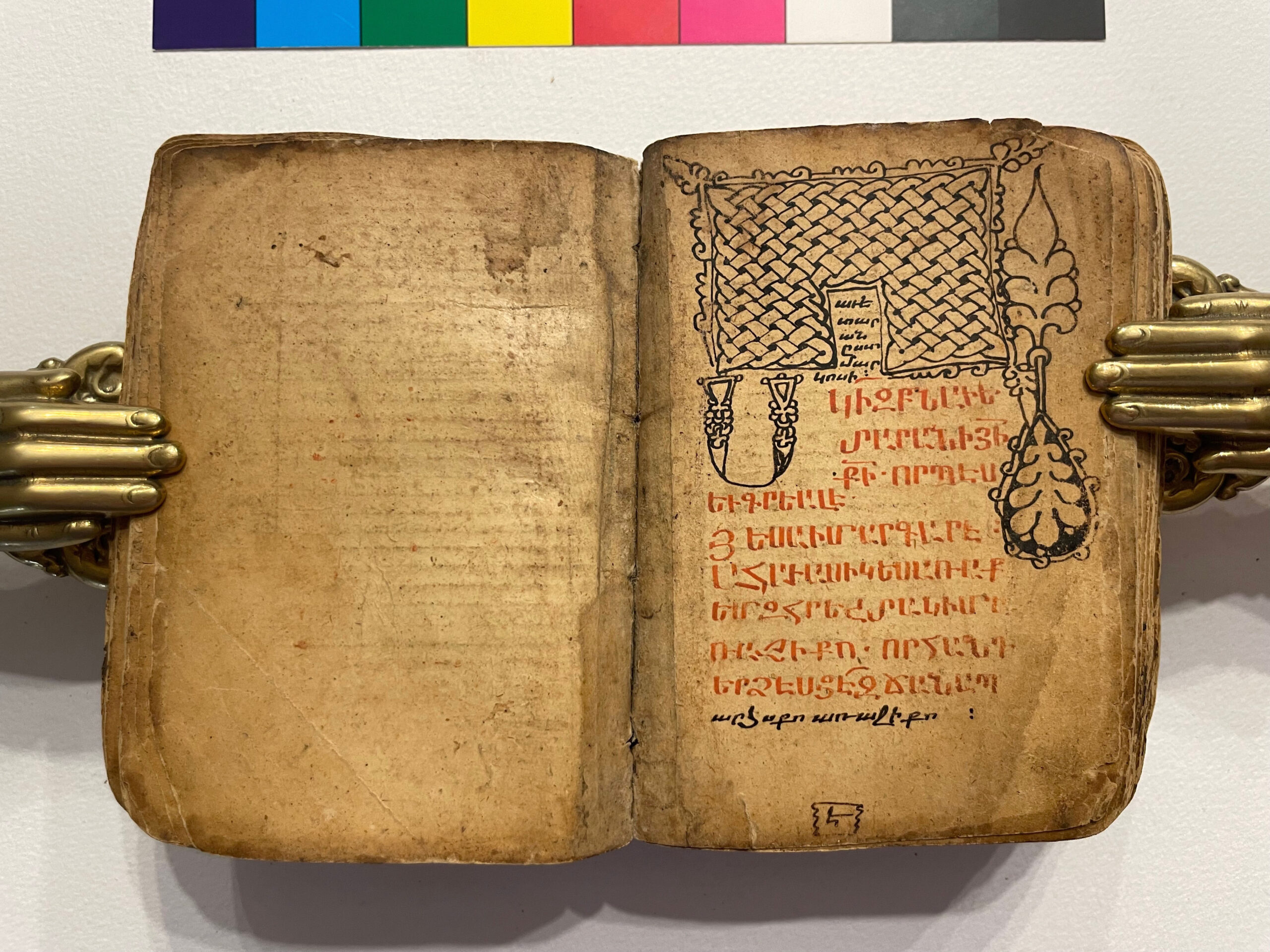
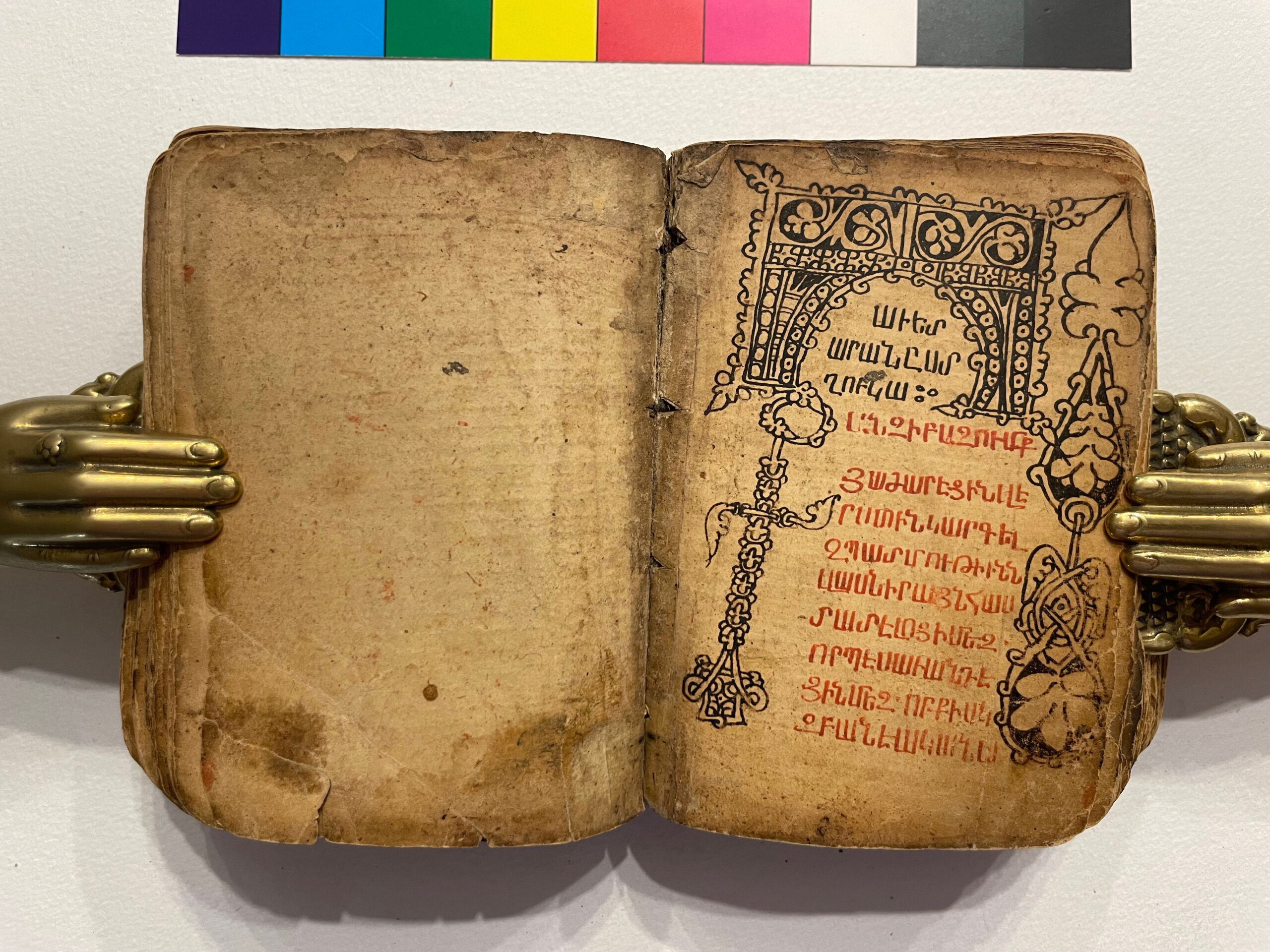
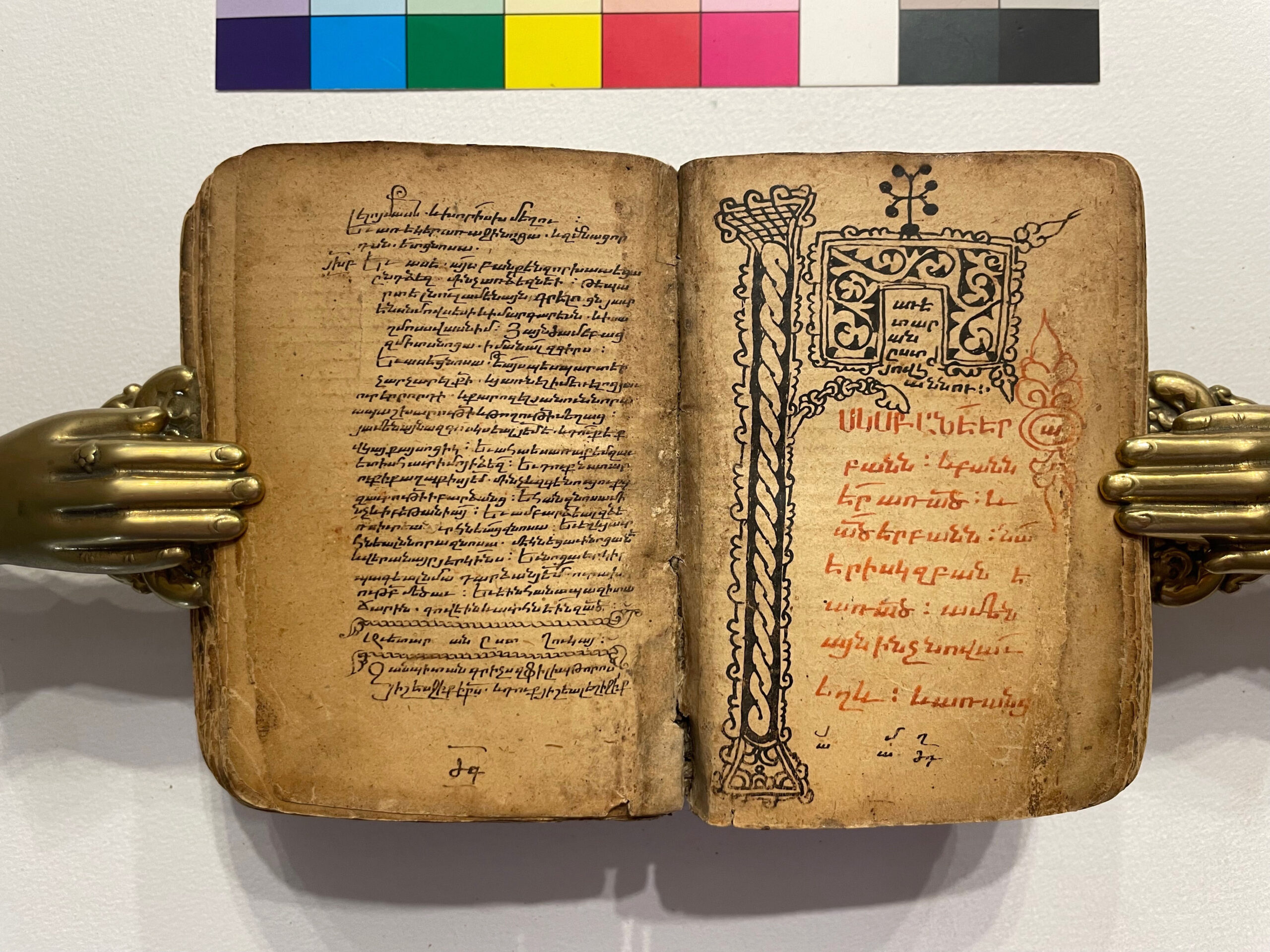
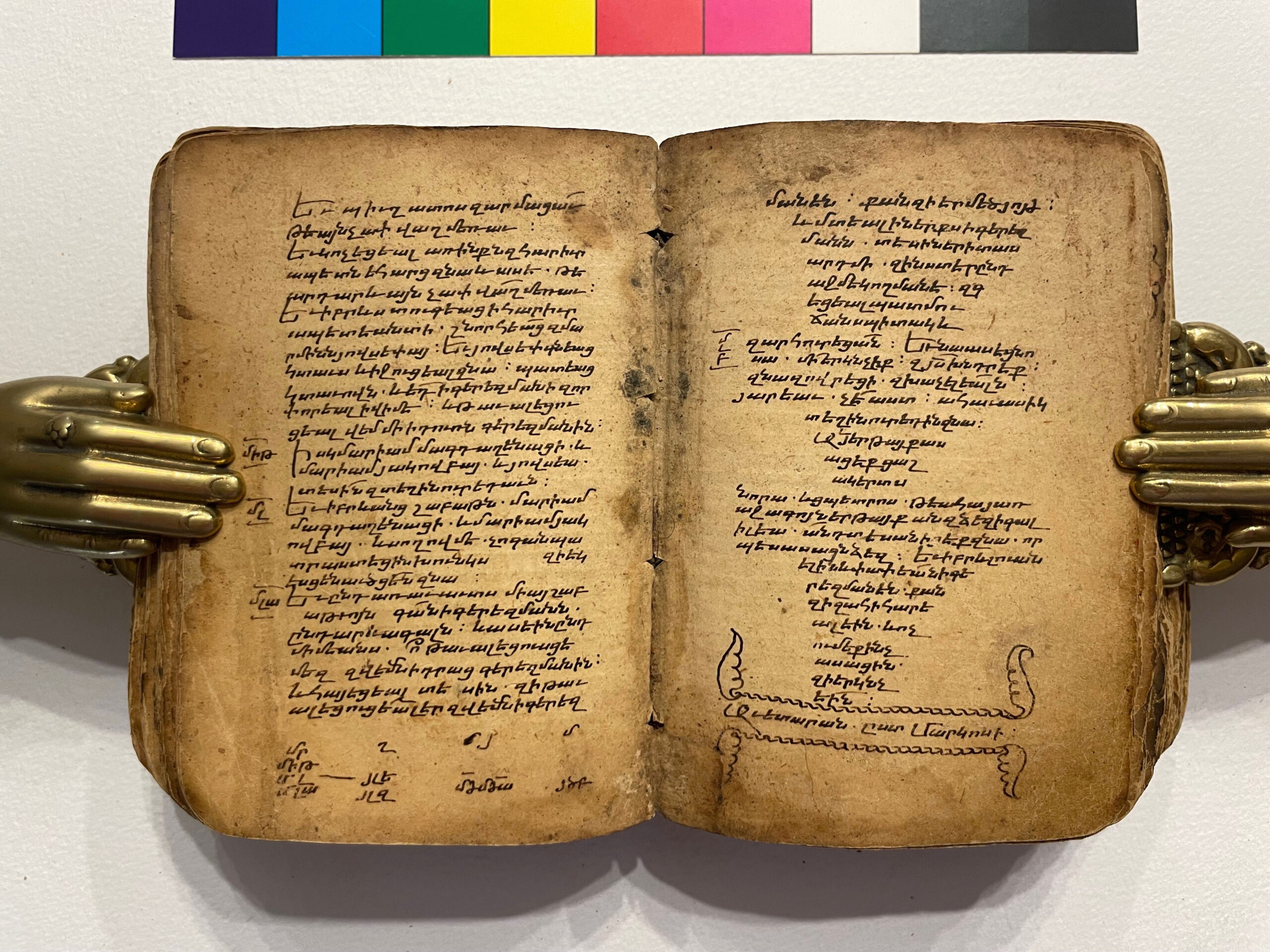
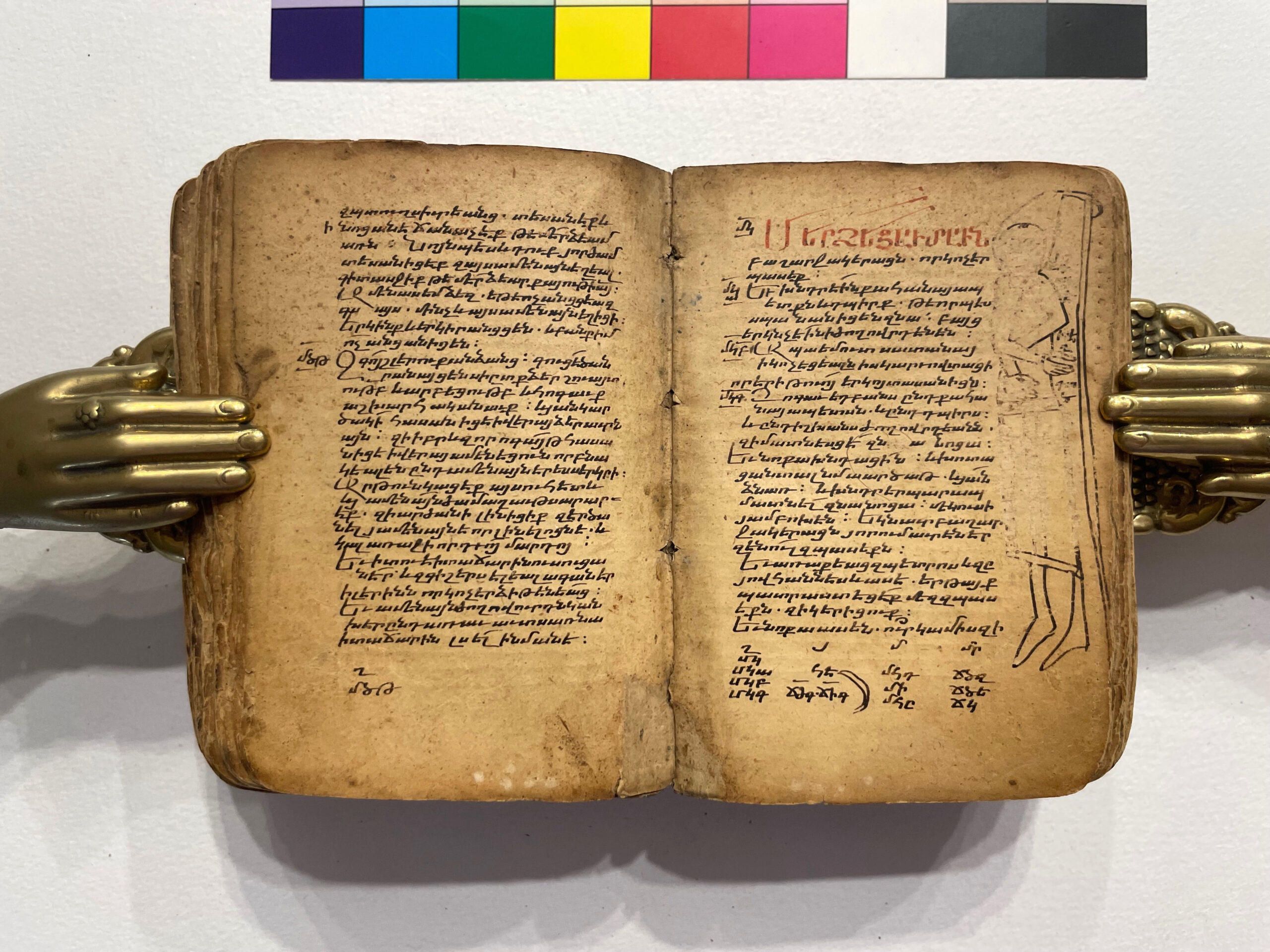
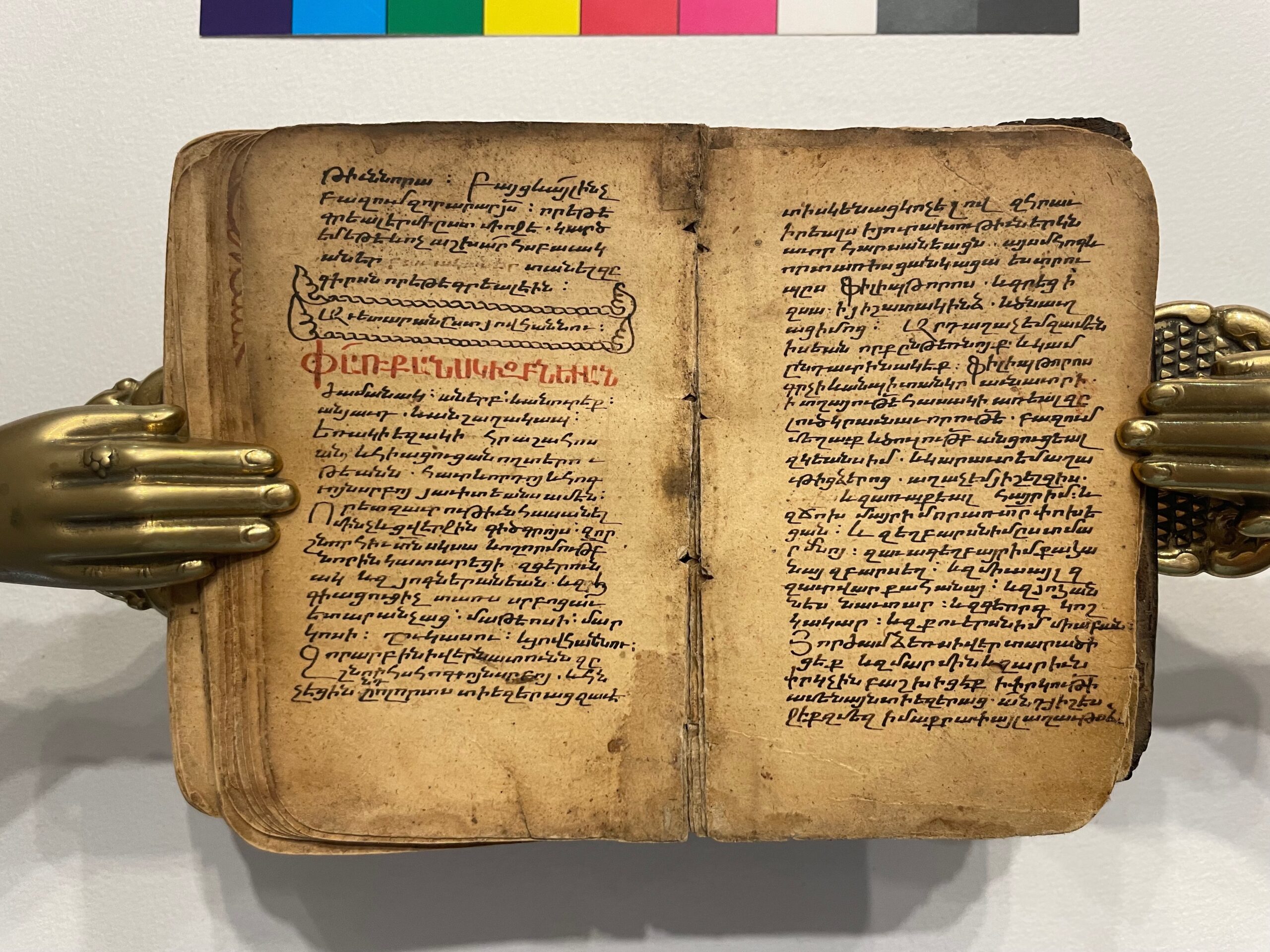
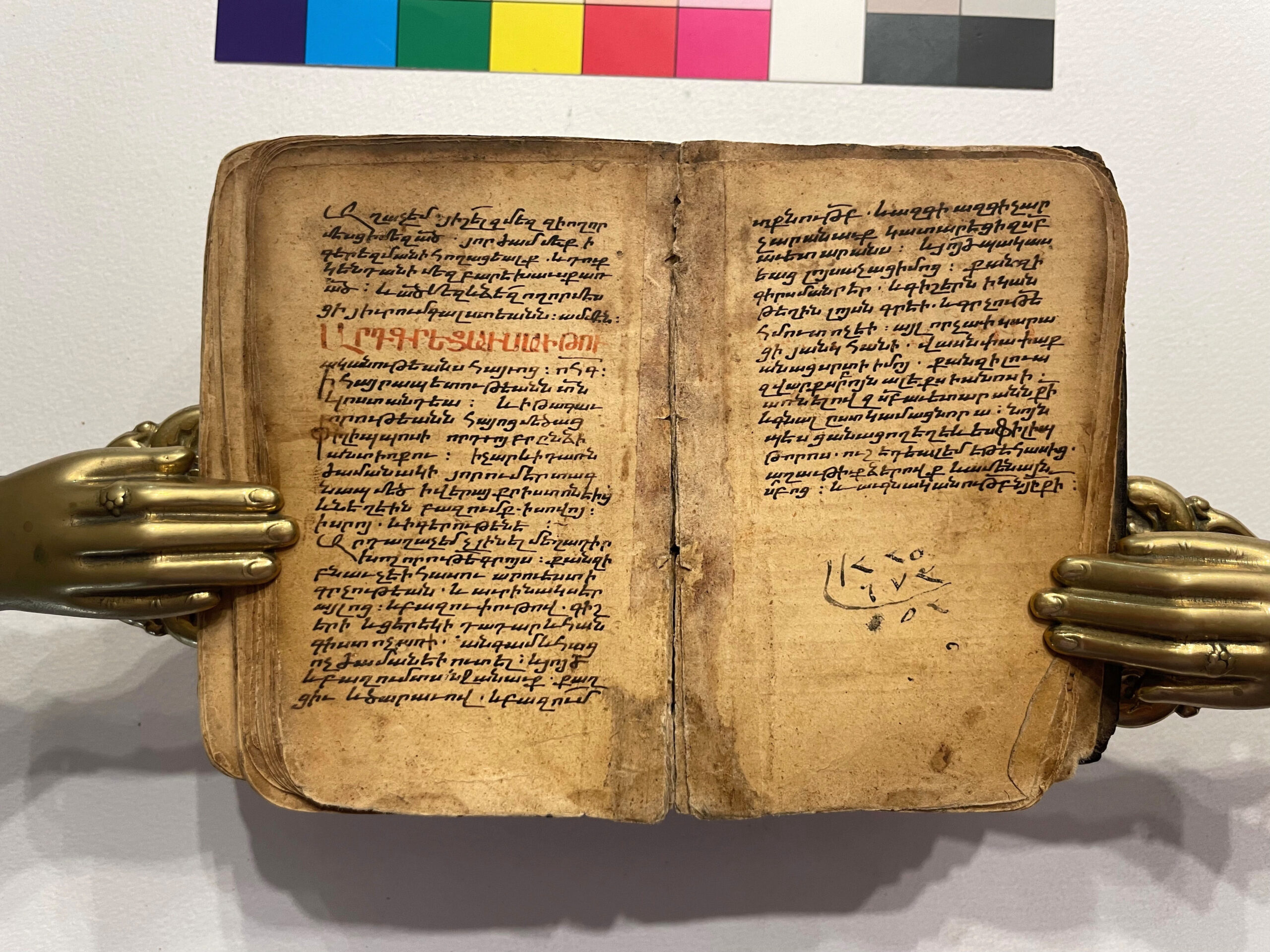
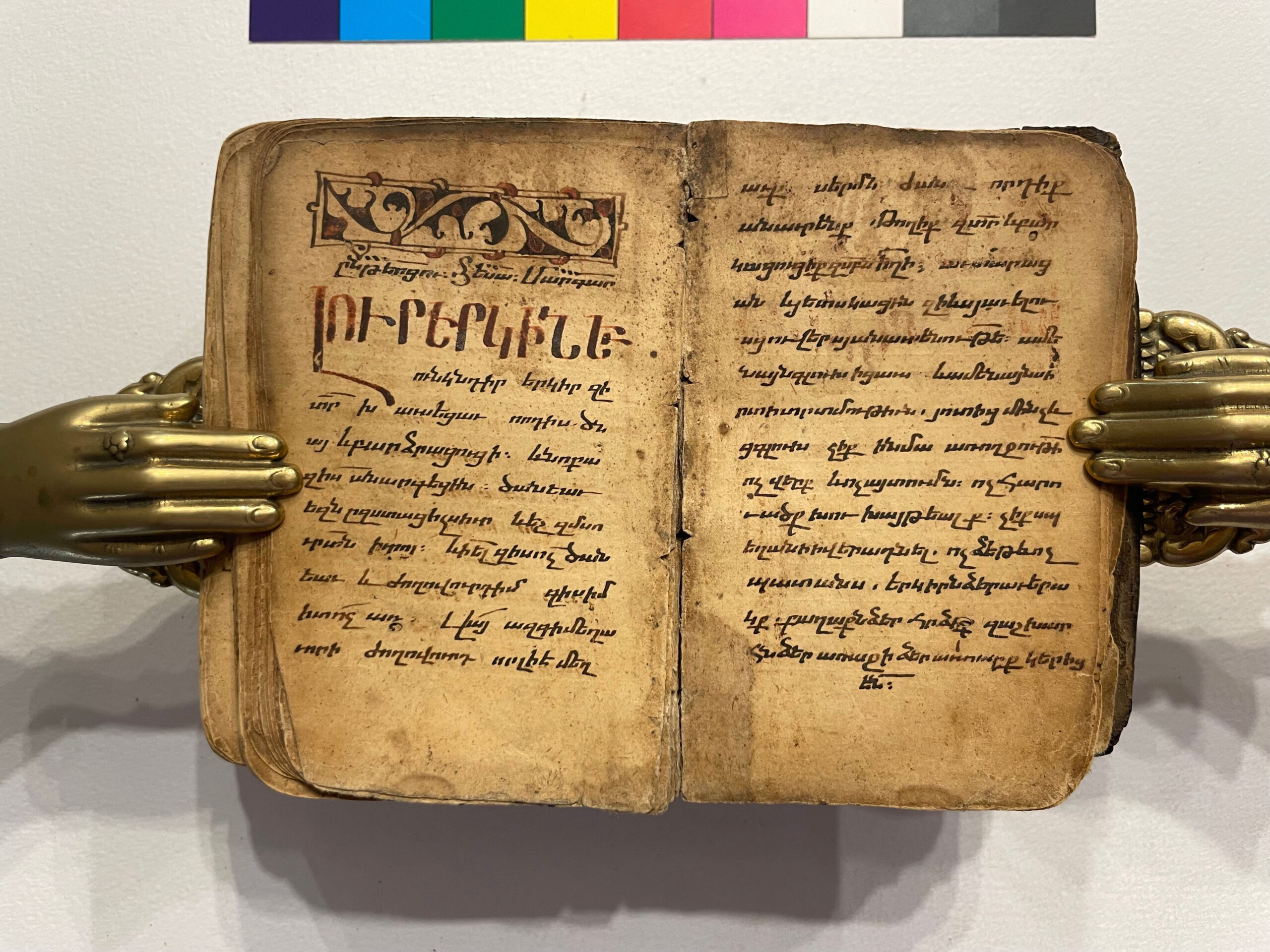
Transcription of the Colophon
Փառք անսկիզբն եւ անժամանակ։ աներբ։ եւ անուրեք։ անյաւդ. եւ անշաղակապ։ եռակի եզակի հրաշահոսան, եւ հիացուցանող տէրութեանն. հաւր եւ որդոյ եւ հոգւոյն սրբոյ յաւիտեանս ամէն։ Որ ետ զաւրութիւն հասանել մինչեւ ցվէրջին գիծ գրոյս։ զոր շնորհիւ տ[եառ]ն սկսա եւ ողորմութ[եամ]բ նորին կատարեցի զգերունակ եւ զյոգներանեան եւ զ[հո]գիացուցիչ տառս սրբոց աւետարանչաց մաթէոսի։ մարկոսի։ ղուկասու։ եւ յովհաննու։ Զոր արբին ի վերնատունն զշնորհս հոգւոյն սրբոյ. եւ հնչէցին ընդ ոլորտս տիեզերաց զաւէտիս կենաց կոչելով զհրաւիրեալս ի յուրախութիւն երկնաւոր հարսանեացն. այսմ հոգեւոր տառիս ցանկացա ես տրուպս Ֆիլիպթորոս. եւ գրեցի զսա ի յիշատակ ինձ. եւ ծնաւղաց իմոց։ Արդ աղաչեմ զամէնիսեան որք ընթեռնոյք. եւ կամ ընդաւրինակէք։ Ֆիլիպթորոս գրչի եւ անպիտան կրաւնաւորի. ի տղայութե[ան] հասակի առեալ զլուծ կրաւնաւորութե[ան]. բազում մեղաւք եւ ծուլութ[եամ]բ անցուցեալ զկեանս իմ. եւ կարաւտ եմ աղաւթից ձերոց. աղաչեմ յիշել զիս. եւ զառաքեալ հայր իմ։ եւ զճոխ մայր իմ որ առ տ[է]ր փոխեցան։ եւ զեղբարսն իմ ըստ մարմնոյ։ զաւագ եղբայր իմ քահանայ զբարսեղ։ եւ զմի[խ]այլ զզաւրվար քահանայ։ եւ զյոհաննէս նաւտար։ եւ զգէորգ կոշկակար։ եւ զքուերսն իմ միաբան։ Յորժամ ձեռս ի վեր տարածիցէք եւ զմարմին եւ զարիւն փրկչին բաշխիցէք ի փրկութի[ւն] ամենայն տիեզերաց. անդ յիշէսջիք զմեզ ի մաքրափայլ աղաւթսն։ Աղաչեմ յիշել զմեզ զի ողորմէսցի մեզ ա[ստուա]ծ. յորժամ մեք ի գերեզմանի հողացեալք. եւ դուք կենդանի մեզ բարէխաւսք առ ա[ստուա]ծ։ եւ ա[ստուա]ծ մեզ եւ ձեզ ողորմէսցի յիւրում գալստեանն։ ամմէն։ Արդ գրեցաւ սա ի թուականութեանս հայւոց ոհգ [673]։ Ի հայրապետութեանն տ[եառ]ն Կոստանդեա։ եւ ի թագաւորութեանն հայոց մեծաց Փիլիպպոսի որդւոյ բրընձի անտիոքու։ ի չար եւ ի դառն ժամանակի յորում էր տագնապ մեծ ի վերայ քրիստոնէից՝ եւ նէղէին բազումք. ի սովոյ։ ի սրոյ. եւ ի գերութենէ։ Արդ աղաչեմ չլինել մեղադիր խոշորութե[ան] գրոյս։ քանզի բնաւ չէի հասու արուէստի գրչութեան. եւ աւրինակս էր այլոց։ եւ բազու[մ] փութով. գիշերի եւ ցէրեկի դադար եւ հանգիստ ոչ առի. անգամ եւ հաց ոչ ժամանէի ուտել։ եւ յոյժ եւ բազում տանջանաւք. քաղցիւ եւ ծարաւով. եւ բազում տքնութ[եամ]բ. եւ ազգի ազգի չարչարանաւք կատարէցի զս[ուր]բ աւետարանս։ եւ յոյժ պակասեաց լոյս աչաց իմոց։ քանզի գիրս մանր էր. եւ գիշերն ի կանթեղին լոյսն գրէի. եւ գրչութե[ան] հմուտ ոչ էի։ այլ որչափ կարացի յանկ հանի. վասն փափաքանաց սրտի իմոյ. քանզի լուա զվարք սրբոյն ալեքսիանոսի. առնելով զս[ուր]բ աւետարանն Ք[րիստոս]ի եւ գնալ ըստ կամաց նորա։ նոյնպէս ցան[կ]ացող եղէ եւ ես Ֆիլիպթորոս. ուշ եդեալ եմ եթէ հասից. աղաւթիւք ձերովք եւ ամենայն ս[ր]բոց։ եւ աւգնականութ[եամ]բն յ[իսուս]ի ք[րիստոս]ի։
Translation of the Colophon
Glory to the astounding Lordship without beginning and without time, without when and without where, without conjunction and without bond, triune, singular, from whom flow miracles, to the Father and to the Son and to the Holy Spirit, unto ages, Amen; Who gave me the energy to arrive at the final line of this book. By the grace of the Lord I began, and by the mercy of the Same, I completed[27] this sublime, much blessed, and animating book of the evangelists, Matthew, Mark, Luke, and John, who imbibed the grace of the Holy Spirit in the Upper Room and announced the Good News of life throughout the entire universe, calling those invited to the joy of the heavenly wedding banquet.
I, the lowly Filip-Tʿoros, desired this spiritual book and copied it as a memorial for myself and my parents. Now, I beseech all of you who read and or copy [this book] [to remember] Filip-Tʿoros the scribe and worthless monk, who took upon myself the yoke of celibacy at a young age, lived my life with many sins and in a lazy manner, and am in need of your prayers. I beseech [you] to remember me and my father Aṛakʿeal and my mother Chokh,[28] who have departed to the Lord, and my brothers according to the flesh: my older brother, the priest Barsegh,[29] Mikhayl[30] the commander priest, Yohannēs[31] the notary, and Gēorg[32] the shoemaker, together with my sisters.
When you spread out your hands and distribute the body and blood of the Savior for the salvation of the whole universe, then remember us in your pure and radiant prayers.[33]
Now this [book] was written in the year 673 of the Armenian Era [1224 ad][34] during the patriarchate of Lord Kostandin[35] and during the reign over Greater Armenia of Pʿilippos,[36] the son of the prince of Antioch, in an evil and bitter time in which there was great trouble for Christians, and many were afflicted by famine, by the sword, and by captivity.
Now, I beseech you not to blame me for the crudeness of my writing, because I was never trained in the scribal arts[37] and my model was [the handwriting] of others.[38] And in great haste [I copied], and I took no rest or break by night or day. At times, I did not even manage to eat bread. With much and many torments, with hunger and thirst and much sleeplessness and all manner of suffering, I completed this Holy Gospel. And the light of my eyes was greatly diminished,[39] because the writing was tiny, and I copied at night by the light of a lantern. And I was no expert in writing. But I succeeded as best I could, for the sake of my heart’s longing. Because I heard the life of St. Alekʿsianos,[40] who took[41] the Holy Gospel of Christ and walked according to His will. In the same manner desired I, Filip-Tʿoros, and strove that I might attain [the kingdom] by your prayers and [by the prayers] of all the saints, and by the help of Jesus Christ.
Jesse Siragan Arlen is the director of the Krikor and Clara Zohrab Information Center at the Diocese of the Armenian Church of America (Eastern) and a postdoctoral research fellow in Armenian Christian Studies at the Orthodox Christian Studies Center of Fordham University.
[1] As a starting point, see Avedis K. Sanjian, “The Historical Significance of Colophons of Armenian Manuscripts,” Le muséon 81 (1968): 181–95; idem, Colophons of Armenian Manuscripts, 1301–1480: A Source for Middle Eastern History (Cambridge, MA: Harvard University Press, 1969); Gérard Dédéyan, “Les colophons de manuscrits arméniens comme source pour l’histoire des croisades,” in The Crusades and their sources: essays presented to Bernard Hamilton, eds. J. France & W.G. Zajac (Aldershot, Hampshire-Brookfield, VT: Ashgate, 1998), 89–110; J.J.S. Weitenberg, “Cultural Interaction in the Middle East as Reflected in the Anthroponomy of Armenian 12th–14th Century Colophons,” in Redefining Christian Identity. Cultural Interaction in the Middle East since the Rise of Islam, eds. J.J. van Ginkel, H.L. Murre-van den Berg & T.M. van Lint (Leuven: Uitgeverij Peeters-Departement OOsterse Studies, 2005), 265–273; Aida Gureghian, “Eternalizing a Nation: Armenian Hishatakarans in the Seventeenth Century,” Church History 79 no. 4 (2010): 783–799; Anna Sirinian, “On the Historical and Literary Value of the Colophons in Armenian Manuscripts,” in Armenian Philology in the Modern Era: From Manuscript to Digital Text, ed. Valentina Calzolari (Leiden: Brill, 2014) 65–99; Gohar Grigoryan Savary, “Armenian Colophons on the Takeover of Sis (1375),” RÉArm 40 (2021): 85–99; Emmanuel van Elverdinghe, “‘A Child in Zion:’ The Scriptural Fabric of Armenian Colophons,” in Receptions of the Bible in Byzantium: Texts, Manuscripts, and their Readers, eds. Reinhart Ceulemans and Barbara Crostini (Uppsala: Uppsala University Library, 2021), 141–162.
[2] See the bibliography in Sirinian, “On the Historical and Literary Value,” op. cit., 95–100 and in van Elverdinghe, “‘A Child in Zion,’” op. cit., 160.
[3] van Elverdinghe, “‘A Child in Zion,’” op. cit., 142.
[4] Emmanuel van Elverdinghe, “Recurrent Pattern Modelling in a Corpus of Armenian Manuscript Colophons,” Journal of Data Mining and Digital Humanities, Episciences.org, 2018, Special Issue on Computer-Aided Processing of Intertextuality in Ancient Languages, ⟨10.46298/jdmdh.1401⟩. ⟨hal-01283638v2⟩.
[5] Sirinian, “On the Historical and Literary Value,” op. cit., 76–85.
[6] Emmanuel van Elverdinghe, “Armenian Colophons as Literary Compositions” in Handbook of Armenian Literature, eds. Theo Maarten van Lint and Emilio Bonfiglio (Leiden: Brill, forthcoming).
[7] Adapted from Sanjian, Colophons of Armenian Manuscripts, 7–9 and Sirinian, “On the Historical and Literary Value,” op. cit., 75–76.
[8] Theo Maarten van Lint, “Armenian Colophons in Verse, 1641–1660,” in Colofoni Armeni a Confronto: Le Sottoscrizioni Dei Manoscritti in Ambito Armeno e Nelle Altre Tradizioni Scrittorie Del Mondo Mediterraneo : Atti Del Colloquio Internazionale, Bologna, 12-13 Ottobre 2012, eds. Anna Sirinian, Paola Buzi, and Gaga Shurgaia (Roma: Pontificio Istituto Orientale, 2016), 73–84; idem, “Some Further Observations on Colophons in Verse: The Earliest Two Examples,” RÉArm 39 (2020): 169–186.
[9] Sirinian, “On the Historical and Literary Value,” op. cit., 76.
[10] Philip of Antioch, first consort of Queen Isabella (r. 1219–1252) from 1222–1225. Philip of Antioch was the son of Bohemond IV (prince of Antioch, 1201–1216, 1219–1233). His short reign ended with his imprisonment and death by poisoning for the details of which, see Jacob G. Ghazarian, The Armenian Kingdom in Cilicia during the Crusades: The Integration of Cilician Armenians with the Latins, 1080–1393 (London: Routledge, 2000), 55; Ani Atamian Bournoutian, “Cilician Armenia,” in The Armenian People from Ancient to Modern Times, vol. 1: The Dynastic Periods: From Antiquity to the Fourteenth Century, ed. Richard G. Hovannisian (New York: St. Martin’s Press, 1997), 273–291 at 285.
[11] Mkrtichʿ Awgerean, ed., Liakatar varkʿ ew vkayabanutʿiwn srbotsʿ (Complete Lives and Martyrology of the Saints), 12 vols. (Venice, 1810–1814), vol. 9, 388–42; Varkʿ srbotsʿ harantsʿ ew kʿaghakʿavarutʿiwnkʿ notsʿin (Lives of the Holy Fathers and Their Way of Life), 2 vols. (Venice, 1855), vol. 1, 138–161; Bibliotheca Hagiographica Orientalis, ed. Socii Bollandiani (Brussels, 1910), 10–11.
[12] On Armenian scripts and paleography, see Michael E. Stone, Dickran Kouymjian, and Henning Lehmann, Album of Armenian Paleography (Copenhagen: Aarhus University Press, 2002.
[13] Matthew R. Crawford, The Eusebian Canon Tables: Ordering Textual Knowledge in Late Antiquity (Oxford: Oxford University Press, 2019).
[14] Awetaran ateni (Gospel of the Atean) (Jerusalem: I tparani aṛakʿelakan atʿoṛoy srboy Yakovbeantsʿ, 1873).
[15] On the textual problems involved with the ending of the Gospel of Mark, see Bruce M. Metzger and Bart D. Ehrman, The Text of the New Testament: Its Transmission, Corruption, and Restoration (Oxford: Oxford University Press, 2005, 4th ed.), 322–327.
[16] See Athanase Charles Renoux, Le codex arménien Jérusalem 121, 2 vols., Patrologia Orientalis 35–36 (Turnhout: Brepols, 1969–1971); Khajag Barsamian, The Calendar of the Armenian Church (New York: St. Vartan Press, 1995).
[17] This passage is read on the Third Sunday after Pentecost.
[18] This passage is read on two of the major feast days of the Holy Cross: Exaltation of the Cross (Խաչվերաց) and Discovery of the Cross (Գիւտ խաչ).
[19] This passage is read on several feast days for major saints celebrated on Saturdays, including Sts. Athanasius and Cyril of Alexandria, St. Cyril of Jerusalem, the Holy Archangels Gabriel and Michael, among others.
[20] This passage is read on the Feast of Saint Nersēs the Great (Catholicos, sed. 353–373).
[21] This passage is read on the Feast of the Annunciation to the Holy Virgin Mary (Աւետումն).
[22] This passage is read on several feast days associated with the Holy Mother of God and other female (especially virgin) saints, including the Feast of the Annunciation to the Holy Virgin Mary (Աւետումն), the Remembrance of the Dead (յիշատակ մեռելոց) on the day after the Feast of the Assumption of the Holy Mother of God (Վերափոխումն), the Presentation of the Holy Mother of God to the Temple (Ընծայումն), the Feast of St. Gayianē and her companions, among others.
[23] This passage is read in the days following Easter (Զատիկ) and on the Feast of St. John the Forerunner.
[24] This passage is read in the days following Easter (Զատիկ).
[25] Achaṛean knows of only one other figure with a similar name (Ճոխեր, Chokher). Interestingly, this figure is mentioned in a colophon of a manuscript dated exactly the same as ours (1224 ad) (Venice ms. no. 200, f. 527v). See H. Achaṛean, Hayotsʿ Andznanunneri Baṛaran (Dictionary of Armenian Personal Names), 5 vols. (Erevan: Petakan Hamalsarani Hratarakchʿutʿyun, 1942–1962), s.v. Chokher.
[26] I am uncertain exactly what this implies.
[27] On this formula, see Sirinian, “On the Historical and Literary Value,” op. cit., 77, 79–80.
[28] See n. 25 above.
[29] Basil
[30] Michael
[31] John
[32] George
[33] On this formula, see Sirinian, “On the Historical and Literary Value,” op. cit., 78.
[34] The Armenian Era, which commenced in 551 ad, was adopted by the Armenian Church during the Second Council of Dwin in 554 ad. Thus, to convert dates from the Armenian Era to the Gregorian calendar (ad), one adds 551 to the Armenian Era date. So here, 673 Armenian Era plus 551 gives 1224 ad. For more on Armenian calendrical systems, see A. G. Abrahamyan, Hayotsʿ gir ev grchʿutʿyun [Armenian Letters and Writing], (Yerevan: Yerevani Hamalsarani Hratarakchutʿyun, 1973), 96–177.
[35] Catholicos Kostandin (Constantine) I of Cilicia (sed. 1221–1267).
[36] See n. 10 above.
[37] Literally, ‘I never attained the scribal art.’
[38] I.e., he was never trained to write as a scribe. He therefore only imitated or copied the handwriting he saw in the exemplar(s) before him.
[39] I.e., his eyesight suffered due to copying the Gospel.
[40] See n. 11 above.
[41] Or, ‘made’ (առնելով).
